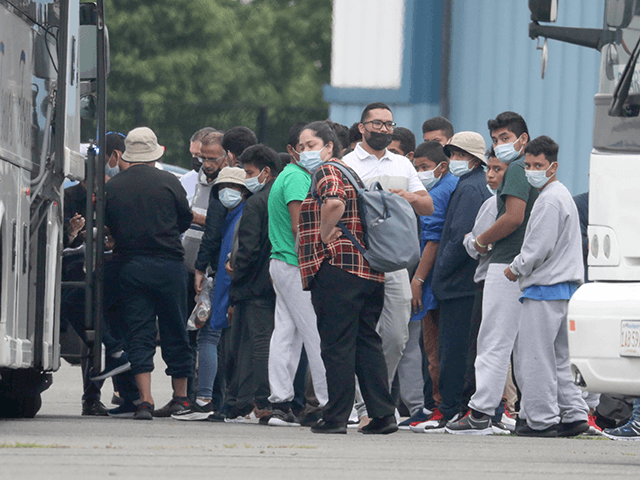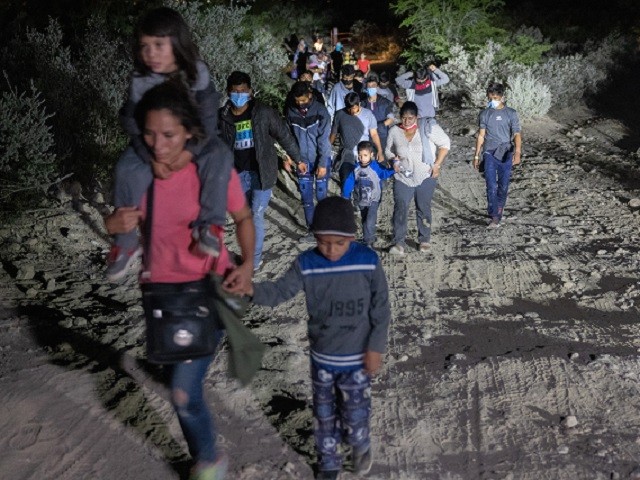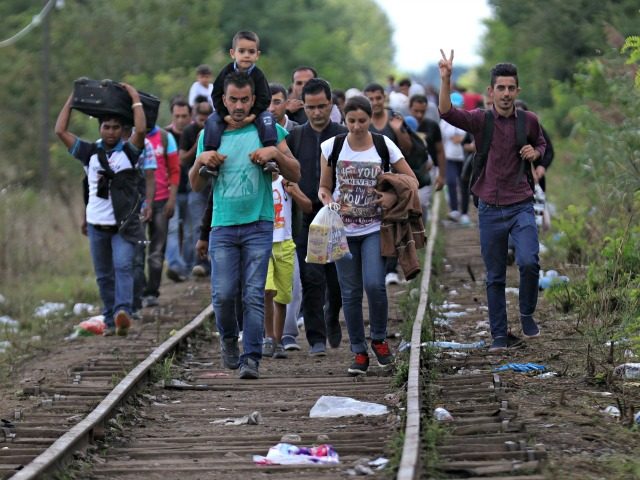The Democrats’ amnesty bill quietly invites three million chain-migration arrivals into the U.S. workforce, likely forcing Americans to pay higher rents.
“It’s a huge deal,” said Jessica Vaughan, the director of policy studies at the Center for Immigration Studies.
About four million people are now waiting many years to get one of the roughly 240,000 cards annually available for the foreign siblings and adult children of legal immigrants. The new bill would allow them to “Early File'” for conditional residency and work permits if they have been waiting for more than two years and can also fly into the United States.
“A lot of people who are on the waiting list will come here and ‘Early File’ for … ‘green-card lite’ status,” Vaughan said. President Joe Biden’s deputies will likely allow the chain migrants to fly into the United States under the pretense that they are short-term tourists, she added.
The chain-migration arrivals “will go to where [their migrant relatives] are concentrated, and many are already living in a high-cost-of-living area — Prince William County, and Prince George’s County in Maryland, for example,” she said.

Young people board a bus after disembarking an airplane at Westchester County Airport Aug. 16, 2021. Westchester County Executive George Latimer said that the county airport is being used as part of a reunification effort between children crossing the U.S. and Mexico border and their parents. (Seth Harrison/The Journal News via Imagn Content Services)
“There clearly will be a very large demand for housing, and particularly for low-income housing which we already have a massive shortage of,” said Rosemary Jenks, the director of government relations at NumbersUSA. “So yeah, this is going to exacerbate every social problem that we have.”
The Wall Street Journal reported September 14 on rent increases:
Rents tracked by Zillow, an online real-estate company, were up 9.2% in July from a year earlier, as demand increased among people who can’t afford to buy homes and some young professionals returned to cities. Zillow estimates the typical U.S. rent in July was 2.9% higher than if rents followed their pre-pandemic trend.
Those rising rents have created tax-and-spend opportunities for the Democratic Party, where far-left legislators, such as Rep. Ayanna Pressley (D-MA), are demanding tighter government oversight of landlords, and are seeking taxpayer cash for renters. Pressley already won $5 billion in extra federal spending on housing, much of which will help landlords charge higher rents.
The invite to chain migrants is buried in legal jargon that media reports have largely ignored. The reporters prefer to focus on the award of citizenship to younger ‘dreamer’ migrants, Temporary Protected Status (TPS) migrants, and essential workers, including the many migrant farmworkers that minimize investors’ need to buy high-tech, labor-saving machinery.
Reporters, business groups, progressives, and Democrats are also silent about the new rules that would allow U.S. employers to import an unlimited number of foreign graduates into the white-collar careers sought by U.S. graduates.
Likely three million of the four million population of waiting chain migrants will arrive in a short time, doubling the inflow of legal immigrants over the next three years, Vaughan said, adding:
The Biden administration’s attitude is that there should be no restrictions on these applicants, and there’s no downside to letting them in years earlier than they otherwise would be … They see these people as pre-immigrants and they want to streamline the process of them getting to the United States, whether to get a work permit [by Early File] or to get their green card.
The bill also allows officials to print additional green cards, under the claim that some green cards from prior years were not used. If 400,000 of those new cards are allocated to family migrants, then 400,000 additional chain migrants will fly into the United States with green cards.
Each year, the government welcomes roughly 1 million migrants via the work visa, diversity lottery, and chain-migration pathways.
Democrats want to expand the extraction of migrants from poor countries, despite public opposition.
But donor-funded GOP leaders are not trying to win worried swing voters by offering pocketbook gains from real immigration fixes. Instead, they downplay the pocketbook impact of migration on Americans’ communities and try to focus GOP base voters on the subsidiary symptoms of migration, such as migrant crime, the border wall, border chaos, and drug smuggling.
Nationwide, the home construction sector has built far too few starter homes since 2006. For example, the sector has annually built less than 150,000 homes smaller than 1,400 square feet since 2009, according to a May 2021 report by home mortgage giant, FreddieMac. The report is titled “Housing Supply: A growing Deficit.”

Immigrants walk towards a U.S. Border Patrol checkpoint after they crossed the Rio Grande from Mexico on August 14, 2021 in Roma, Texas. (John Moore/Getty Images)
The Biden administration has recognized the housing shortage and price spikes.
“National home prices, as measured by the Case-Shiller Index, increased by 7 to 19 percent (year-over-year) every month from September 2020 to June 2021 [and] outpaced income growth in 2020,” it said in a September 1 announcement by Biden’s economic advisors, including Jared Bernstein. Their post continued:
For the past 40 years, housing supply has not kept pace with population growth … Researchers at Freddie Mac have estimated that the current shortage of homes is close to 3.8 million, up substantially from an estimated 2.5 million in 2018 …
One of the most important is that the number of new homes constructed below 1,400 square feet—typically considered “entry-level” homes for first-time homebuyers—has decreased sharply since the Great Recession and is more than 80 percent lower than the amount built in the 1970s. Similarly, entry-level homes are becoming a smaller fraction of the new homes that are being completed, representing less than 10 percent of all newly constructed homes, compared to roughly 35 percent in the 1970s. These dynamics mean that the critically important “bottom rung” of the home-ownership ladder is far too out-of-reach for young families trying to start building housing wealth.
From 2012 through 2016, the apartment industry built roughly 250,000 new apartment homes each year, according to the National Apartment Association. At that race, the inflow of chain migrants would occupy all the new apartment buildings for three years.
The White House report does not mention the economic impact of legal immigration, which adds roughly 1 million people — or roughly 3o0,000 extra households. In 2021, Biden’s deputies are expected to add roughly 2 million legal, illegal, and temporarily legal migrants to the U.S. housing market. That 2021 inflow brings in one migrant for every two Americans born that year.
The amnesty’s offer of residency to the 3 million chain-migration migrants likely could create an additional inflow of 1 million per year — and an extra shortfall of roughly 800,000 apartments or homes.
Many states’ residents are already suffering from high housing costs. For example, several low-income Americans and immigrants died in early September when a storm flooded their affordable basement apartments in New York.
“In New York, there are 37 affordable homes for every 100 low-income renters,” Vox.com reported September 9 in an article about the shortage of housing for the wave of perhaps 100,000 Afghan migrants:
“Housing is the hardest piece to manage for [Afghan] resettlement,” said Alicia Wrenn, senior director for resettlement and integration at the refugee resettlement agency HIAS. “Our clients are coming in with very limited means, and additionally, they don’t have a history here. So you’re scrambling in a housing market that’s tight for all Americans and really tight for low-income people. Depending on the location, it’s more or less acute — but it’s all acute.”
There is much evidence that migration spikes housing prices, greatly to the advantage of real estate investors.
“It almost feels like there is nowhere to go,” Arizona resident Lauren Campos told the Washington Post for a July 10 report about the impact of domestic migration on housing costs:
“It’s just insane everywhere,” said Campos, 28, a lifelong Phoenix resident who has noticed a growing number of California license plates in her complex’s parking lot. “It feels like I’m being chased out of my own home, and it’s the worst feeling in the world.”
…Nationwide, rent prices are up 7.5 percent so far this year, three times higher than normal, according to data from Apartments.com. Analysts expect rent prices to keep climbing for the foreseeable future, a major burden for renters and a warning sign that higher inflation could linger far longer than the White House and Federal Reserve keep predicting.
Housing costs have pushed the poverty rate in California to 15.4 percent, above the 14.5 percent rate in Mississippi, according to the September 14 report by the Census Bureau:
The 11 states for which the SPM [Supplemental Poverty Measure] rates were higher than the official poverty rates were California, Colorado, Delaware, Florida, Hawaii, Maryland, Massachusetts, New Hampshire, New Jersey, New York, and Virginia. The SPM rate for the District of Columbia was also higher.
Immigration has also spiked real estate costs and homelessness in Canada, New Zealand, and Spain. In the United Kingdom, a team of experts suggested the immigration of 4 million has boosted housing prices by 21 percent. A 2013 report by the Reserve Bank of New Zealand reported that even low migration rates spike housing prices for young couples who are trying to raise families:
Net migration changes are consistent with large housing effects. An additional net inflow that adds 1 percent to the population causes an 8 percent increase in house prices over the following three years.
Immigration also curbs Americans’ wages, making it more difficult for them to pay their rising rents. The Washington Post reported July 30 how lower wages and rising rents make Americans subordinate to the government:
Timothy Johnson, a 59-year-old with a chronic hip problem and two young daughters, says his landlord is waiting on $11,000 in unpaid rent for his rent-controlled Bronx apartment. He receives disability payments, and his wife had a job as a department store clerk, but he said it has not been enough to cover the rent.
He said he avoids thinking about what would happen if New York state can’t ultimately provide him and his wife with funds to make up their thousands of dollars in unpaid rent.
“If that happens I’m going to trust in God, because he’s going to make a way,” he said. “He’s always made a way. That’s when your faith kicks in.”
People who earn less than $40,000 a year spend roughly 14 percent of their income on rents. The Wall Street Journal reported that people who earn more than $40,000 tend to spend only 5.5 percent of their income on rent.
The housing gap would likely intensify the pressure by the alliance of progressives, investors, and builders to remove the single-family zoning rules that have enabled suburban neighborhoods since the 1950s. “Let’s Quit Fetishizing the Single-Family Home,” said the headline to an op-ed by columnist Farhad Manjoo in the February 5 edition of the New York Times. “The reign of the single-family home is over. Whatever its habitable charms and nostalgic appeal, the single-family home is out of step with the future,” Manjoo wrote.
Mark Zuckerberg’s FWD.us network is leading the 2021 push for amnesty and more migration. The network’s membership of West Coast investors stands to gain from more cheap labor, government-aided consumers, and room-sharing renters.
The network has funded many astroturf campaigns, urged Democrats not to talk about the economic impact of migration, and manipulated and steered coverage by the TV networks and the print media.

People from Haiti who are seeking asylum in the United States wait for flyers explaining updated asylum policies outside the El Chaparral border crossing on February 19, 2021 in Tijuana, Mexico. (Mario Tama/Getty Images)
The breadth of investors who founded and funded FWD.us was hidden from casual visitors to the group’s website sometime in the last few months. But copies exist at the other sites. Two of the FWD.us founders are advisors to an advocacy group that seeks to raise real-estate prices by adding migrants to states with few migrants.
Many polls show that labor migration is deeply unpopular because it damages ordinary Americans’ career opportunities, cuts their wages, and raises their rents. Migration also curbs their productivity, shrinks their political clout, widens regional wealth gaps, and wrecks their democratic, compromise-promoting civic culture.
For many years, a wide variety of pollsters have shown deep and broad opposition to labor migration and the inflow of temporary contract workers into jobs sought by young U.S. graduates. This pocketbook opposition is multiracial, cross-sex, non-racist, class-based, bipartisan, rational, persistent, and recognizes the solidarity Americans owe to each other.
FWD.us allies have produced multiple reports claiming very small wage gains for Americans. Those claims are cited in a “50 economists” letter and were debunked by Breitbart News in April.

COMMENTS
Please let us know if you're having issues with commenting.